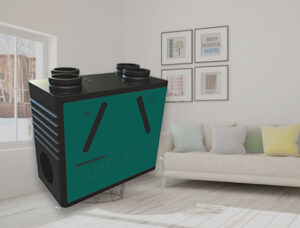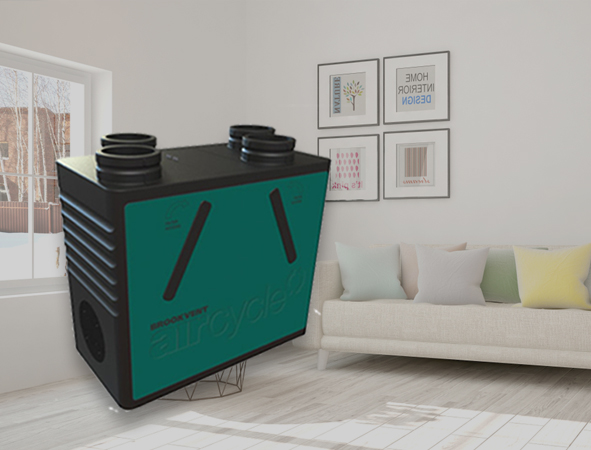Ensuring a healthy living environment has become a priority for many, especially given the increased amount of time spent indoors. A crucial component of maintaining such an environment is the implementation of an effective ventilation system. Not only does it play a pivotal role in circulating fresh air, but it also helps in removing stagnant air that may contain pollutants and allergens. Understanding how ventilation system contributes to creating healthier living spaces can empower homeowners to make informed decisions for their homes and families.
Understanding the Basics of Ventilation Systems
Ventilation systems are fundamental in ensuring the exchange of indoor air with fresh outdoor air to dilute and eliminate airborne pollutants, excess moisture, and odors, thereby safeguarding air quality within indoor spaces. Key types include natural, mechanical, and hybrid systems. Natural ventilation utilizes the passive movement of air through open windows, doors, and other openings, leveraging differences in air pressure to facilitate air flow. Mechanical ventilation systems, conversely, employ fans and ductwork to actively manage the intake of fresh air and the expulsion of stale air.
Hybrid systems merge the benefits of both, optimizing air exchange based on conditions. Each system type serves the purpose of maintaining a healthy and comfortable indoor environment by mitigating pollutants and controlling humidity levels, with the choice depending largely on the specific requirements of the building and preferences of its occupants.
For example, large commercial buildings may favor mechanical ventilation systems for comprehensive air control, while residential homes may opt for natural or hybrid systems for energy efficiency and ease of installation. Regardless of the system type chosen, proper installation and maintenance are key to ensuring optimum performance and indoor air quality.

Combatting Indoor Air Pollution with Air Ventilation System
Indoor environments are susceptible to a variety of pollutants, ranging from volatile organic compounds (VOCs) emitted by paints and furnishings to particulate matter from cooking and dust. Without an effective air ventilation system, these pollutants can accumulate, deteriorating indoor air quality and posing health risks to occupants. A well-implemented ventilation system ensures a constant flow of air, diluting and removing contaminants from indoor spaces. By actively replacing polluted indoor air with cleaner outdoor air, ventilation systems play a critical role in mitigating the levels of indoor pollutants.
This process is especially important in homes where occupants may have respiratory conditions or sensitivities to certain allergens. Additionally, in areas with high outdoor pollution, mechanical ventilation systems equipped with filters can remove outdoor pollutants from the incoming air, further ensuring the cleanliness of the indoor environment. By continuously clearing the air of harmful substances, ventilation systems provide a healthier living space, free from the risks associated with indoor air pollution.
Moreover, a proper ventilation system helps regulate humidity levels, preventing mold growth and other moisture-related issues that could compromise the health of the occupants and the structural integrity of the home. Beyond health, proper ventilation also contributes to comfort, ensuring the air within your living spaces remains fresh and pleasant.
Regulating Humidity Levels for Comfort and Health
Managing the humidity within a home is vital for both comfort and health. Elevated humidity can foster an environment conducive to mold and mildew growth, which can lead to respiratory issues and other health problems. On the other hand, air that is too dry can cause skin irritation and exacerbate respiratory conditions. An efficient ventilation system addresses these concerns by effectively removing excess moisture from the air, maintaining an ideal level of humidity.
This not only ensures a more comfortable living environment but also helps in preventing the growth of mold and mildew, safeguarding the health of the home’s occupants. Additionally, by keeping humidity levels in check, ventilation systems contribute to preserving the integrity of building materials and contents, preventing warping, rot, and other moisture-related damage. The right balance of humidity is crucial for a healthy and comfortable home environment, and a well-designed ventilation system is key to achieving this balance.
To achieve the optimal humidity balance, it’s important to seek professional advice for a well-structured and tailored ventilation system. An expert will be able to design a system that meets your home’s specific needs, considering factors like the size of the property, the local climate, and the occupant’s personal preferences.
Enhancing Energy Efficiency of Home Air Circulation System
Incorporating an advanced home air circulation system in a home not only ensures the circulation of fresh and healthy air but also significantly contributes to the household’s energy efficiency. Modern ventilation technologies have revolutionized the way homes manage indoor air quality, with features such as heat recovery systems. These systems cleverly capture heat from expelled indoor air and use it to temper the incoming fresh air.
This innovative approach minimizes the loss of heat during colder months, reducing the reliance on heating systems and consequently lowering energy consumption. During warmer seasons, certain systems can reverse this process, pre-cooling incoming air and lessening the burden on air conditioning units. This dual capability ensures a comfortable indoor environment year-round while promoting substantial energy savings.
By integrating such efficient ventilation solutions, homeowners can achieve a balance between maintaining optimal air quality and reducing energy costs, highlighting the importance of selecting the right ventilation system tailored to the unique needs of their living spaces. Moreover, given the diversity of available ventilation options, consulting with a professional can ensure the chosen system aligns with the specific structural characteristics and climate of the home. They can also advise on periodic maintenance schedules to ensure the ventilation system remains effective and efficient over time.
Providing a Fresh and Odor-Free Environment
An effective ventilation system is essential in ensuring that your home remains free of the pervasive smells that daily activities can produce. Whether it’s the lingering aroma of last night’s dinner, your pet’s occasional accidents, or the musty scent that comes from a closed-up space, these odors can significantly impact the comfort and appeal of your living environment. By establishing a continuous cycle of air exchange, a ventilation system actively dispels these unwelcome smells.
It works by expelling the stale, odor-laden air and replacing it with fresh, clean outdoor air. This process is particularly beneficial after engaging in activities known to produce strong odors, such as cooking with potent spices or using household cleaning agents. The presence of a ventilation system means that these odors are quickly and efficiently removed, preventing them from settling into fabrics and furnishings. The result is a home that smells fresh and inviting, enhancing the overall quality of your indoor environment and making it a more pleasant place to live and entertain. Furthermore, this system helps to create an overall sense of wellbeing, contributing to a positive mood and a higher level of productivity for everyone residing in the home.
Protecting the Structural Integrity with Air Ventilation System for Home
A well-designed air ventilation system for home is paramount in safeguarding a home against the detrimental effects of moisture accumulation. Moisture, if left unaddressed, can seep into the very framework of a building, causing critical components such as wooden supports and drywall to weaken over time. This weakening not only compromises the home’s structural stability but can also lead to expensive repairs and renovations.
By efficiently removing moist air and replacing it with dry, fresh air, a ventilation system prevents the conditions that favor the proliferation of dampness within walls and ceilings. This proactive approach not only preserves the strength and integrity of the home’s structural elements but also contributes to a more durable and resilient dwelling. Through maintaining a dry and balanced indoor atmosphere, homeowners can avoid the pitfalls of moisture damage and ensure their home remains solid and secure for years to come.
Supporting Overall Health and Well-being
A well-ventilated home is not just about keeping the air fresh; it’s deeply intertwined with the mental and physical health of its inhabitants. Research indicates that living in environments with poor air quality can lead to diminished cognitive abilities, affect mood negatively, and disrupt healthy sleep patterns. These adverse effects on mental health are as crucial as physical health issues, highlighting the importance of a continuous supply of fresh air.
Ventilation systems efficiently reduce the concentration of CO2 and indoor pollutants, thereby facilitating better cognitive functions, mood stability, and enhanced sleep quality. The influence of clean air on the human brain is profound, affecting everything from daily mood fluctuations to overall psychological well-being. By prioritizing the air quality in our living spaces, we’re taking a significant step towards nurturing not only our physical health but our mental state as well, ensuring a holistic approach to well-being that supports a more vibrant, healthy life.
Future-Proofing Your Property with Residential Roof Ventilation Systems
Investing in residential roof ventilation systems offers a strategic advantage for homeowners looking to adapt their properties for the future. As global temperatures rise, ensuring efficient heat dissipation from your attic becomes increasingly important. These ventilation systems are designed to prevent the accumulation of excessive heat under your roof, thereby reducing the demand on your home’s cooling systems during peak summer months. This not only contributes to lower energy bills but also prevents the premature aging of roofing materials caused by excessive heat and moisture.
By managing the temperature and moisture levels in your attic, roof ventilation systems play a crucial role in maintaining the structural integrity of your roof and the overall comfort of your home. The installation of such systems positions your property to better handle the challenges of changing climate conditions, making it a smart choice for homeowners who are mindful of both the environment and their wallets.
FAQs
1. **What’s the recommended frequency for ventilating system maintenance?**
– Keeping your ventilation system in top shape is crucial for its efficiency and longevity. Experts suggest an annual check-up that includes cleaning or replacing filters, ensuring that ducts are clear of debris, and verifying that all components are functioning correctly.
2. **Can ventilation systems provide relief for allergy sufferers?**
– Absolutely. By efficiently filtering out common allergens like dust, pollen, and animal dander from the air, a well-maintained ventilation system can significantly reduce allergy symptoms, creating a more comfortable and healthier living environment for those sensitive to allergens.
3. **What are the financial considerations of installing a new ventilation system?**
– The cost of installing a ventilation system varies based on the system type and your home’s specific needs. While there is an upfront investment, the enhancement in air quality, potential energy savings, and the added value to your property can make it a worthwhile expenditure. It’s advisable to consult with a professional to determine the most cost-effective solution tailored to your requirements.
Conclusion
In sum, integrating a ventilation system into your home isn’t just an upgrade; it’s a necessity for ensuring a healthy, comfortable, and efficient living space. From combatting indoor air pollutants and managing humidity levels to enhancing energy efficiency and protecting your property’s structural integrity, the benefits are comprehensive. Plus, with the added perks of maintaining a fresh, odor-free environment and supporting overall well-being, the investment in a ventilation system clearly aligns with the priorities of modern homeowners. Looking ahead, as we navigate the challenges of climate change and increased time spent indoors, the role of efficient ventilation systems in our homes becomes even more critical. By making this essential addition, homeowners not only secure a healthier and more enjoyable living environment but also invest in the long-term value and sustainability of their properties.
| Other Good Articles to Read |
| Blogs-Peoples |
| Bryan Smith Blogs |
| intellect blogs |
| the fault in our blogs |
| blogs eu |
| oz forums |
| recruitment blogs |
| zet blogs |
| id blogs |
| Blog Studio legale |
| blogs map |
| Related Business Listings |
| Contact Directory |
| Local Business Profiles |

